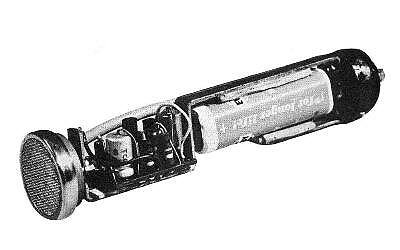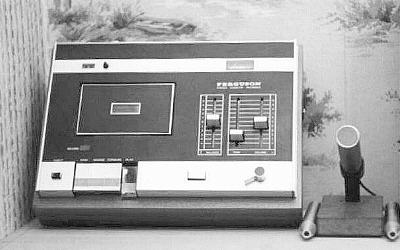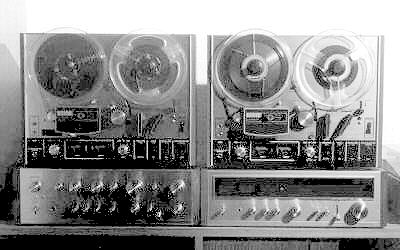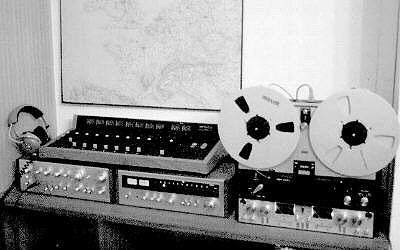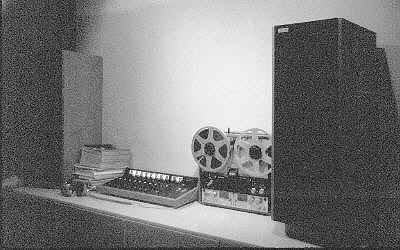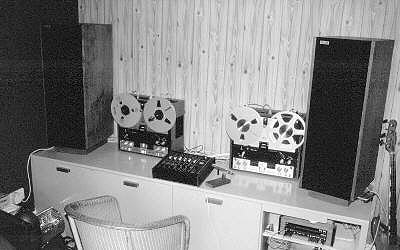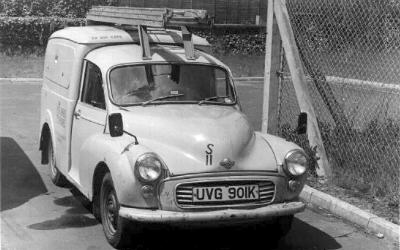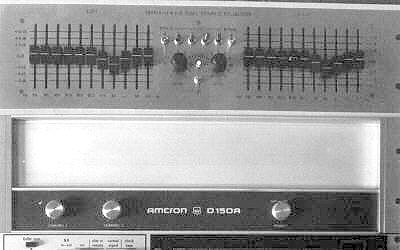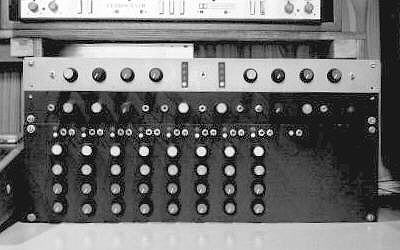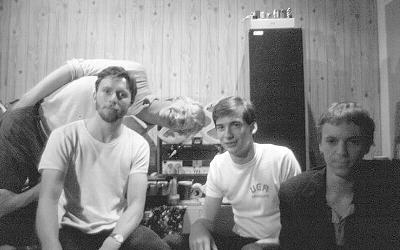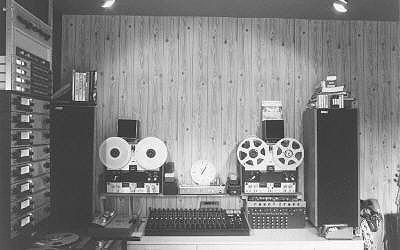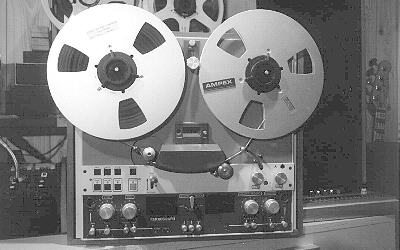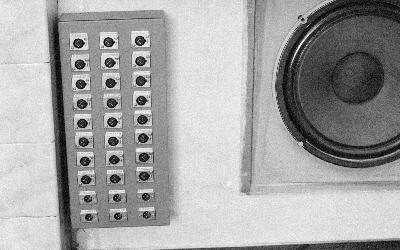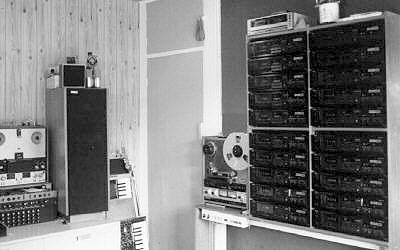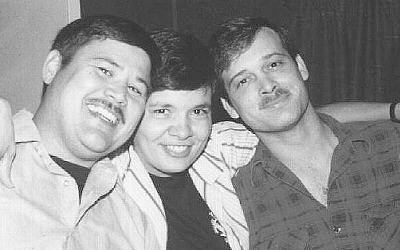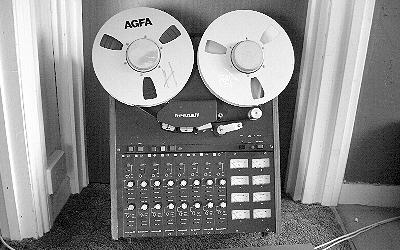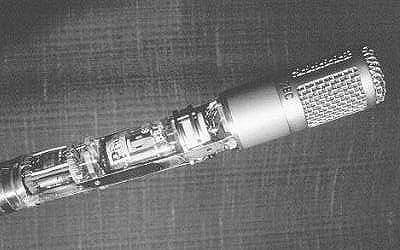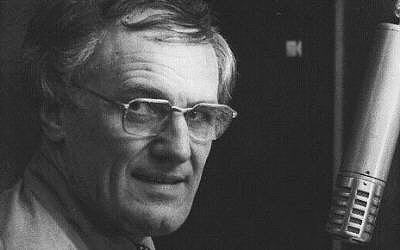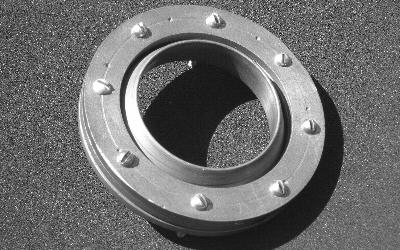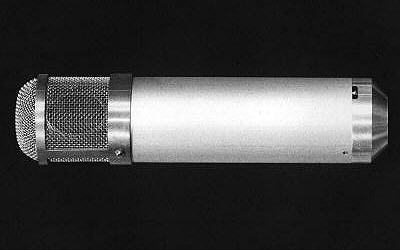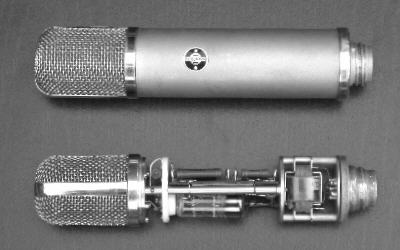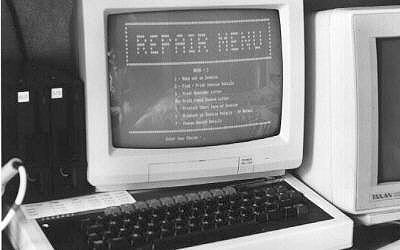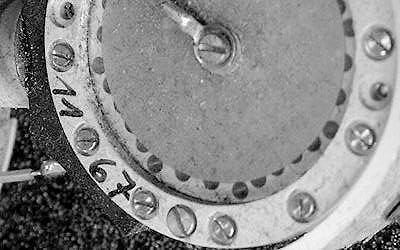----------
|
History - Archive (My own trip down the road of tape recording) |
|
|
For my interest in HI-Fi, see "The Hi-Fi section" |
|
|
|
|
|
1960's - "Hi-Fi" transistor microphone |
|
|
It all began back in the late 1960's, when I built a "Hi-Fi transistor microphone", from a design published in the November 1968 issue of Practical Electronics. A FET type microphone designed around the Acos Mic 39/1 crystal microphone insert. This microphone was to be a upgrade to the the "Basic" Ferguson microphone (based around the Acos Mic 43/3 crystal mic' insert) as supplied with my "Ferguson 3224", 1/2 Track "Mono" valve tape recorder, that I had received as a Christmas present some years earlier. I was studying at Costessey Secondary Modern school (See note) at the time, and therefore able to build/machine the casework for the microphone, during "Metalwork" classes (Teacher, Mr Ernest Parsons). Indeed, the finished microphone being used as a part of the "Practical" work, for my Metalwork GCE O-level exam. I recall that the "Music" teacher, Mrs Ina Bullen, had noticed my interests in music, sometime before I had. Suggesting that I should seriously consider sitting GCE O-level Music. Alas I never did, and as time goes by, I regret that I did not follow her sound advise. (Pun unintended) |
|
|
|
Inside the Practical Electronics "Hi-Fi" Microphone |
|
Note - "Costessey Secondary Modern" school later became Costessey High School, and is now (2010) Ormiston Victory Academy Costessey |
|
|
|
|
|
Early 1970's - "Norwich Tape Recording Society" |
|
|
During the early 70's a good friend and school mate, namely Graham Platt, introduced me to the Norwich Tape Recording Society. A local organization, run by John Butcher, who were affiliated to the "FBTRC" - "Federation of British Tape Recordists and Clubs". (Due to the demise of "Tape" based recording, the FBTRC are now known as "BSRA" - "British Sound Recording Association"). The society regularly had the opportunity to go and record the excellent "Hammond" organ, in the home of Alec Forbes-Wright. The organist being a local piano tuner, namely Eddie Gates. Graham and myself, would go along with our respective tape recorders i.e. Grundig TK120 and Ferguson 3224. We thought it was great, seeing other members of the society with their "Expensive" tape recorders, such as those from Akai (M8), Ferrograph (Series 6/7), Revox (36 series/A77) with microphones by Reslo etc. One of the societies evenings, was a talk by Reg' Williamson, all about the up and coming use of "Cassette" tape/recorders for Hi-Fi purposes. I can still remember the equipment Reg' used for the demonstration i.e. "Cambridge Audio" P100 Pre/Power amplifier and R50 transmission line loudspeakers, together with a "Wharfedale" DC9 cassette deck. I was totally taken by the cassette format and saved up enough money to purchase a "Budget" stereo cassette deck i.e. Ferguson 3257. It was terrible ..... why ever did I buy it ? |
|
|
|
Ferguson 3257 and home made FET "Hi-Fi" microphone |
|
|
|
|
1972/73 - Making various bits and pieces |
|
|
At this time in my life, due to my enjoyment of Hi-Fi, music and sound recording, I was helping a "Local Band" of fellow ex-school mates. The band, named "Feedback", performed covers of popular chart material of that time e.g. David Bowie, Fleetwood Mac, Status Quo, The Beatles, etc. The band members knew of my interest in electronics and I suppose that I was somewhat like a "Roadie", making various bits and pieces, of electronic "Goodies", for the band to try out. Sometimes with a few "Shocking" results along the way. I remember recording one of the first "Feedback" gig's, back on the 22nd September 1973, in Gringleford "Youth Centre" (A village on the outskirts of Norwich). Using my home made FET "Hi-Fi" microphone together with my first Akai 4000DS tape deck. Whilst compiling this page, I wondered what happened to the original recording, alas I fear that it might have been over recorded at some time. Maybe I'll find it one day. The recording was in Mono of course ! |
|
| Akai 4000DS | |
|
|
|
|
1973/74 - "Track Bouncing / Sound on Sound" |
|
|
My interests in music and recording developed from this time onwards.. Sometime around 1973/74, I was running something akin to a small "Private" studio, in my home of New Costessey, a village just on the outskirts of Norwich, in Norfolk (Gt. Britain). Like so many enthusiasts, I started off "Track Bouncing / Sound on Sound" and in my case, I used a pair of "Redundant" Hi-Fi tape machines. Both being Akai 4000DS 1/4 track stereo units, one from my own Hi-Fi, the other, purchased from a very good friend, and work colleague, namely Bernard Wells. Being 1/4 track, with a top speed of just 7 1/2 ips, the Akai 4000DS's were not the quietest machines in the world. Having said that, they were not so bad, they certainly enabled me to do most jobs that I asked of them and proved to be excellent pieces of equipment to learn on. |
|
| Recording Set-up, Circa 1973 | |
|
|
|
|
1975 - "Homebrew" 8-2 mixer |
|
|
Then in 1975, I upgraded to a Ferrograph "Super Seven" tape recorder, model 7504HD. A Three Speed ,1/4 track "Stereo" machine, with Dolby B noise reduction. Originally to be used as my Hi-Fi tape deck. Although the Ferrograph was in a totally different class to my Akai 4000DS machines, they had served me very well and gave excellent value for money. Also, 1975 was to see the purchase a pair of AKG C451E / CK1 microphones (Still in use today) and the construction of a very basic "Homebrew" 8-2 mixer. The later based around the microphone pre-amps used in the Ferrograph super seven tape recorder and the excellent ITZA virtual earth mixing amp's, designed by Mike Skeet. One of the first recordings that I made with the Ferrograph / AKG combination, was that of a family wedding. |
|
| Recording Set-up, Circa 1975 | |
|
|
|
|
1976 - We all had to start somewhere |
|
|
Recording in the "Lounge" was not an ideal situation. I needed a separate room for recording purposes, so like many of us, it was to be my bedroom. So during 1976, the room was re-decorated, creating the required "Atmosphere" for the task required. Monitoring via a stereo clone of the famous "Quad II" valve power amplifier and a pair of "Hi-Fi Answers" Transmission Line loudspeakers (Designed by Chris' Rogers). The later being very similar to the Cambridge Aiudio R50 loudspeakers, offering a very "Accurate" LF performance. Both the amplifier and loudspeakers being home built in 1975. Used together with the Ferrograph 7504HD tape recorder and Homebrew 8-2 mixer, I was now ready to record my own efforts at playing, fumbling about, on Bass Guitar and Keyboards. Well, we all had to start somewhere. The Bass Guitar was built by Paul Butler, Bass Guitarist in the 1970's local band "Feedback". |
|
|
|
Recording Set-up, Circa 1976 |
|
|
|
|
1977 - Quick "Fix" |
|
|
Some months later, in 1977, I acquired yet another Ferrograph "Super Seven", type 7522HD, being a 1/2 track "Stereo" machine, with Dolby B noise reduction. Although being an "Ex-Demo" unit, from a local Hi-Fi showroom, it had seen very little use/abuse. Not designed to work at 15 ips with Dolby "In", it needed a quick "Fix" to overcome that small problem i.e disabling the operation of a relay at 15 ips. I also modified the Ferrograph 7522HD to "Balanced" microphone inputs with 48v phantom power. It was now possible to go out and record on location e.g. Brass Bands, Cinema / Fairground Organs, Rock Groups etc. Back home, I was track bouncing between both of the Ferrograph tape machines, in stereo, via an ever growing homebrew Patch Bay and a small TEAC "Model 2" 6-2 mixer. The later item being on loan from a good friend, and equipment reviewer, namely Mike Skeet. Upon returning the TEAC 6-2, I purchased an MM electronics MP175 16-2 mixer to keep me going. It was cheap, and surprisingly cheerful ..... |
|
| Recording Set-up, Circa 1977 | |
|
|
|
|
The 70's - On Reflection |
|
|
This was a fairly good start, but it soon became apparent that I required better quality equipment and more tracks. During the past few years, I was still serving my apprenticeship at the GPO, now known as British Telecom (BT), training to become part of the engineering staff. Spending much time attending Norwich City (Technical) College. The company (BT) knew of my interest in sound recording and approached me to transfer an old "Post Office Telephones" demonstration record to 1/4" tape, for use in the local "Norwich Area" Telephone Museum. The 78 rpm record, titled "Automatic Telephone Tones", contained examples of tones, together with an explanation of their meaning, that the "Caller" could expect to hear when using the telephone. The record required a considerable amount of "Electronic" cleaning to produce a satisfactory copy. Looking back, I still remember purchasing my first copy of "Studio Sound", back in January 1975, and reading the various articles during lunch breaks. That year, 1975, I visited the APRS exhibition, held in London. Needless to say, that I was totally amazed at the equipment on display. Equally, it was blatantly obvious, that the items I sought, were way out of my reach of my price range, based on an BT "Apprentices" wages ! |
|
| Fond memories..... | |
|
|
|
|
The 80's - A New Era |
|
|
Ideally, the majority of the equipment that I was to purchase, would need to be sourced at secondhand prices. Indeed, much of it, such as the Ampex AG 440-8 multi-track recorder / Studer B62 mastering recorder / 2 x Dolby A360 with Cat 22 (A type) / 2 x Dolby A361 with Cat 280 (SR type) Noise Reduction modules / Amcron DC150A Power Amplifier / Klark Teknik 11+11 S Graphic EQ and AKG BX15 "Spring" Reverb, were all purchased through local auctions or the sale of redundant equipment by companies, such as the BBC and Decca, etc. A suitable space / home, would need to be found, so that I could fit the above equipment into my recording environment. The requirement / need to build some solid 19" rack units became a necessity. Needless to say, there were very many hours spent making up suitable leads and cabling the units to the ever "Expanding" patch-bay. This was not a task that I enjoyed doing by any means, being so repetitive and boring, but it's one that has to be done. |
|
| Monitor Amplifier and EQ Rack | |
|
|
|
|
1980 - Homemade units and Modifications |
|
|
The cost of purchasing "Outboard" units, such as Noise gates, Compressor limiters and Delay / Double Tracking devices, would be quite considerable. Therefore I decided to construct "Homemade" Clones of various models available in that era, such as units from Rebis Audio etc. My first project being a 19" rack unit, containing 8 Noise Gates, which would help to keep "Background" noise levels down during mix-down. The Ampex 440-8 was quiet enough, but the residual noise of my recording environment was quite high e.g Aircraft and Motor vehicle noise. The "Homemade" rack unit also contained the power supply for the noise gates and other units. The mixer in use, at this time, being the weakest link by far, was my old MM 16-2. This was quickly modified with "In House" designed (quieter) microphone pre-amps, and later (1982) with direct channel output's etc. However, for the time being, at least I would be able to lay-down "Clean" tracks. So the MM 16-2 did the job, just. The idea of building a custom mixer seemed like the next sensible move. After designing the circuitry required, I started building the case / framework, for a 24 input desk. Sadly, mainly due to the lack of spare time, the project never saw completion. |
|
| "Homemade" Clones | |
|
|
|
|
1981 - Introduction to Valve Microphones |
|
|
Many of the microphones were purchased through adverts in Studio Sound and various other magazines of that period. My very first purchase, of a valve microphone, was an STC 4108, costing £30 at a local Auction. Alas, the microphone did not have a lead or power supply unit, but the original items were to be found at another auction a year on ... strange, but I was lucky to find them. Later, an AKG C28 costing £75, complete with C29a (short) and C30a (long) extension tubes. Then, probably one of my best finds, a Neumann KM56 and M49, at £50 each. You could not by a good dynamic microphone for that price, yet alone a top flight valve microphone. I knew at that time, that these were good microphones, but I did not really appreciate their true quality and value until some years later. Although they where not all in good working order, at those prices it did not really matter. The sound quality of my recordings changed completely. It was like being in a different world, I was now able to produce recordings "Approaching" a professional standard. |
|
| M49, KM56, 4108 and C28 | |
|
|
|
|
1981 - Half speed backing tracks |
|
|
One of the first recordings made, using the Ampex 8 track, was that of a local Singer / Songwriter "Andy Lake". Andy, then working for BT, was interested in doing some recording, and I was keen to master the art of using the Ampex. We were basically stacking tracks. One of the tracks that Andy recorded, was called "Italian Princess". This was an instrumental track with an Italian feel to it. Now ..... not having the luxury of a Balalaika, or similar stringed instrument, we had to find an alternative way to recreate that type of sound. After some thought, I decided to record the acoustic guitar at half speed. Andy would then play the respective parts an octave below normal pitch, whilst strumming / picking the guitar at double the speed (relative to that of the half speed backing tracks), not easy. Thus sounding similar to that of a Balalaika, when played back at the correct speed. Thanks to Andy's excellent guitar playing, the effect worked surprisingly well. |
|
| KM56 used during the recording of "Italian Princess" | |
|
|
|
|
1981 - Radio One, "John Peel" show |
|
|
A relation of the family, namely Alex de Findlow, also a fellow BT engineer at the time, was the drummer in a local band called "Ju-Ju" (Previously known as "The Flying Opticians"). The band required a suitable recording for the BBC's, Radio One, "John Peel" show So, the four piece band arrived one evening after work, and we recorded the track "Keep out the light". At this time the MM electronics 16-2 mixer did not have direct channel outputs and therefore track laying on the Ampex was a bit "Make do" to say the least. I recall mixing the Drum Kit into a stereo pair. With the Vocal and Saxophone parts being sent to tape, via separate auxiliary sends. The Bass and Electric Guitars were DI fed directly into the respective inputs of the Ampex. I listened eagerly to the playback, on the John Peel show, only to hear the first 5 seconds played at half-speed ! |
|
| "Ju-Ju", the band members in the control room | |
|
|
|
|
1982 - At long last ..... |
|
|
Although I was running on a small budget, I was able to fill up my studio with some genuine professional equipment. My trusty old Ferrograph's, being used for delay and echo loops, with the Studer B62 for Mastering, via Dolby A or SR if required. The "Heavily Modified" MM 16-2 mixer now had direct channel outputs, being interconnected to the Ampex 440-8 track via the ever growing Patch Bay. At long last, I was in a situation to start some "Serious" recording. My first ambitious multi-track session, was that of a local band, namely "Airbridge". I was very lucky to have the good fortune to work with such a talented group of musicians. Despite my lack of recording skills, the session went very well and the recordings met with everybody's satisfaction (as did my mothers "Famous" cheese rolls and coffee). Many more recording sessions were to follow, and I would have the privilege of working with the likes of Derek Cubitt, the late Derek Warne and many others. Not forgetting the help and assistance, from an excellent arranger / musician / teacher Phil Brooke, whilst recording and mixing many sessions for Tony Palmer of "City Music" (Also known as Anglian Music). |
|
|
See the "Recording Sessions" page for further information. |
Recording Set-up, Circa 1982 |
|
|
|
|
1983 - "Biased" for minimum modulation noise |
|
|
Yet another "Ferrograph" turned up, at a "Silly" price. This was one of the newer "Logic 7" series i.e. basically the same as the older "Super Seven" series, with logic transport control and colour change. It was a "Stereo" 1/2 track machine, high speed version, being disposed of by the BBC. The machine was in excellent working / cosmetic order and only required a good clean, head demag' and "Line-up". The recorder was quickly sold to a local musician, who was setting up a home studio. Like the rest of my analogue tape machines, the Ferrograph Logic 7 was "Biased" for minimum modulation noise i.e. Record a very low frequency sine wave, say 5 Hz, and adjust the bias for minimum modulation noise (a sort of fluffing noise). With a recorder "Biased" in this fashion, the extreme HF might not be quite so good as is practically possible, but in my opinion, the "Clean / Solid" audio reproduced, certainly makes up for it ! |
|
|
|
Ferrograph Logic 7 |
|
|
|
|
1984 - "Non-commercial" |
|
|
My "Private" studio (Bedroom) was hardly big enough for the recording local "Rock Groups/Bands" etc. I needed more space, to fit the musicians and equipment, especially the drum kit. Although recording many various artists etc, I was running a "Non-commercial" studio i.e. Making free recordings, whilst learning the skills of recording. I could not afford the costs of a purpose built recording area, and therefore, the lounge would still be used for this purpose. Cables from microphones and DI boxes etc, draped through the hallway between the lounge and bedroom. This was far from an ideal situation. Tie-circuits were needed to connect the lounge (Studio) to the bedroom (Control Room). A collection of balanced cables were used, being laced together into a neat loam. These were run in hidden conduit, from the lounge, up into the loft space and back down into the bedroom. A pair of "Tannoy" HPD385's, in brick enclosure's and being used for the Hi-Fi system, were utilised for talkback/monitoring purposes. |
|
| Tie-cable box and one of the talkback speakers | |
|
|
|
|
Mid' 80's - Cassette Duplication |
|
|
By now (mid 1980's) my "Facility" offered recording ... right through to "Real-time" cassette duplication. Something which was becoming very popular in that era. Starting with just 20 "Yamaha 3-head" cassette decks (Slaves) and an Otari MX-5050 2SH, 2Tk "Stereo" tape machine (Master). I went on to acquire 30 Denon DR-M44HX, 3-head, (Slave) cassette machines. Giving me a total of 50 cassette decks in all. The "Production Masters" for cassette duplication, were now transferred to a Sony PCM F1 system. By utilizing a selection of "Recorded Tones", generated via an "In house" design/built "Black Box" interface, the F1 stereo analog audio tracks were now used as the "Control tracks" for the Cassette recorder transport functions, including "Eject". The duplication system was fully automatic. All I had to do, was load the cassettes and press "Play" on the Sony PCM F1. If there was any audio "Drop out", the system sounded an alarm and automatically rewound all the cassettes back to the start. |
|
|
Cassette Duplication area (Early) |
|
|
|
|
|
1987 - American Influence |
|
|
One of the many local artists, that I recorded for Tony Palmer of "City Music", was that of "Budgie Coleman". A very popular "Country" singer, known throughout the length and breadth of the British Isles, with a lifetime of entertainment under his belt. Budgie regularly playing at the USAF bases, here in Great Britain, and paling up with some of the American bands / musicians. During the recording of Budgies album, "I'll sing you a summer", Budgie called on the assistance of such an American "Country Rock" band, for some session musicians, just to give the album that American influence. The band in question being "The Silver Eagle Band". After Budgie's session work was completed, I asked the "The Silver Eagle Band" if they had any of their own songs that they would like to record. At that time they had little or no material of their own. However, one of the members of the band, namely Dan Demay, wrote four songs that we recorded a week or so later, for use as a Demonstration / Promotion Cassette entitled "Blue Jeans". It was great to hear the American influence in Dan's writing and the bands playing qualities. Deeply missed, enjoyable days ..... |
|
|
Session musicians were ..... PH, Mary and Dan |
|
|
|
|
|
1989 - Location Recording |
|
|
I was enjoying the benefits associated with the 1" 8 track format e.g. low noise, excellent headroom, etc. If only I was able to go out on location with the same format. So, I looked around for a suitable recorder i.e. Brenell Mini-8. I found a secondhand one with low head wear, but alas not in very good cosmetic/electrical condition. However, after much TLC, the recorder was back in good running order again. Now having two recorders of the same format, I was able to make straight copies of my multi-track masters ... quite useful. Now I required some form of mixer, for use with the Brenell, and an old MM 8-2 was soon found. This would need to be modified in the same way as my studio mixer i.e. "In House" designed (quieter) microphone pre-amps, with direct channel output's etc. However, the "Location" mixer would require the benefits of multi-way connectors, one for the Brenell record/playback link and the other for the microphone inputs to the mixer. The later being connected to a stage box, via a suitable trailing lead. So at last, a nice convenient and relatively portable "Location" set-up, using the 1" 8 track format. |
|
|
See the "Recording Sessions" page for further information. |
Brenell Mini-8 recorder, Circa 1989 |
| - - - - - - - - - - - - - - - - - - - - | |
|
Decision time ..... a financial point of view |
|
|
Time ticked by, and it was becoming quite obvious, that I was not going to be able to operate my recording facility as a business. The dreams that I had, would not be turning into reality. There would be very little return from the relatively high investment costs that I had incurred. By this time, 1994, I had purchased a Studer A80 mk2, 16 track, running at 15/30ips, together with an Allen & Heath "Saber" 24-16-2 desk. The Studer A80 is very clean sounding recorder, but I preferred the sound of the Ampex 440-8. Less tracks and flexibility, but the Ampex was the one for me. The Ampex is great for recording, and capturing the feel, of those "Ben Webster" style jazz sessions. The Studer was short lived and was sold after just 1 year. As for the Allen & Heath desk, I never found the "Sound" very "Useful". Indeed, as sad as it might seem, I preferred the sound from my modified MM electronics 16-2 mixer. |
|
|
I was now looking at all of this equipment from a financial point of view, and the idea of cassette duplication was the first side of the facility to be scraped, with the majority of the cassette decks being sold to a local musician, for use in their own duplication set-up. However, I went on to purchase a pair of Alesis ADAT recorders and a portable, Casio DA-7, DAT recorder. This up-to-date equipment was to see very little use, just a few AV sessions etc, and my time in recording came to a gentle halt. I would still keep the rest of the recording equipment / musical instruments for my own use, with the idea of recording my own material etc. |
|
| - - - - - - - - - - - - - - - - - - - - | |
|
Repairing Microphones |
|
|
As already mentioned, many of the microphones, and other equipment, were purchased in an "Unknown Condition", this meant that I would be required to spend plenty of time, learning about the design and construction of the "Non-working" units, which was to hold me in good stead for the future. I suppose that you could say my first "Repair" job, was on my own "Very sick" AKG C28a. Not having any circuit diagrams, I had to trace out the wiring and draw the circuit for the microphone/ PSU. Being of simple design, this was an easy task. Using my "Hand Drawn" circuit diagram, together with my knowledge in valve/semiconductor electronics, that I had learnt during my GPO (BT) training, I was soon able to find the fault and restore the unit back to life. |
|
| Inside an AKG C28a, with an C28c grill/mesh | |
|
The "Reg' Williamson" connection |
|
|
Sometime during 1985, I purchased an another AKG C28, from a fellow colleague at BT, namely the famous Reg' Williamson. Well known and respected for his many Hi-Fi related "Write-up's". Reg's first venture into technical journalism, was an article entitled "The design and construction of a capacitor microphone", published in the August 1959 edition of "Hi-Fi News" . Sometime later, Reg' designed a capsule, for use in an RF type microphone. The microphone being designed by both Reg', and an associated friend, Peter Baxandall. Description of the microphone, was given by Peter Baxandall, in the Nov/Dec 1963 editions of "Wireless World". All the capsules used by Reg', were built from scratch i.e. the raw materials were machined to the required size etc and the gold foil, for the diaphragm, was mounted and tensioned on a homemade jig. (Reg' Williamson, 1926 - 2009) |
|
|
See some of Reg's excellent HiFi equipment designs. |
Reg' Williamson, together with the finished RF microphone. |
|
"Aladdin's Cave" |
|
|
So, back to my purchase of Reg's old AKG C28 valve microphone. Along with the C28, associated PSU and leads, I was also given a box of "Goodies". It was like looking into "Aladdin's Cave", this box included Reg's original Valve and RF type microphones, together with the relevant paperwork/write-up. As can be seen from the recent picture, taken in 2005, the microphones are still in good cosmetic condition. After having been stored in my loft for many years, and therefore exposed to a somewhat "Cruel" environment, the microphones had developed numerous faults. However, after some TLC, I am pleased to say that the microphones are now back in good working order. |
|
| Reg's original "Valve" (Upper) and "RF type" (Lower) microphones | |
|
One of my most treasured possessions |
|
|
There was also a good supply of gold and aluminum foil, found in this box of goodies, together with Reg's homemade "Diaphragm Tensioning" jig. Of relatively straightforward design, the jig is used to hold the gold or aluminum foil in the correct location, during the fitting and tensioning of a "Condenser / Capacitor" capsule diaphragm. The jig was somewhat worse for wear and had a few screws missing, but after some tidying up and TLC, the jig was to become one of my most treasured possessions. Enabling me to refurbish many an old "Damaged" capsule and to "Have a go" a building some capsules of my own.. Tracking down suppliers of the foil is a problem, but fortunately a roll lasts many years. |
|
| Capsule Jig, used for "Diaphragm Fitting / Tensioning" | |
|
First "Homebrew" valve microphone |
|
|
Needless to say, being a DIY fanatic, I was very temped to build a valve microphone for my own use. I now had all the suitable components and engineering tools required, together with access to a suitable lathe, to construct my own microphone. So I found a suitably "Low Noise", wire ended valve, and designed a circuit around it. The design, used one of Dr Sowter's excellent transformers, for the valve out-put impedance/level matching. A home made capsule, to one of Reg' Williamson's designs, was also used. Looking like a "Slim" Neumann U47, the microphone offered switchable Omni, Cardioid and Fig'8 polar patterns. The results were most impressive, and the unit is still in good working order. |
|
| First "Homebrew" valve microphone | |
|
Back to the AKG C28 ... Colin Clark |
|
|
In early 1991, my AKG C28 acquired from Reg' Williamson, developed another fault. I contacted AKG (UK) for some assistance in obtaining some spare parts i.e. Output transformer. I spoke to their service engineer of that time, namely Colin Clark, who was very helpful and only too willing to offer any advise that he could. Not only was Colin a "Freelance Service Engineer", he also ran his own business, that of "COLIN CLARK Electronic Servicing" (Watford), repairing all kinds of Audio and Electronic equipment. A true genius at his work. Also being a great "Believer" in the freedom offered by Pirate Radio, such as that of "Radio Caroline" etc. (Colin Clark, 1949 - 2008) |
|
|
Colin Clark at his home in Ireland (Photograph by Dave Finn) |
|
|
Would I be interested in servicing a Neumann .... |
|
|
In July of 1991, I recall contacting "Jackson Music", re the purchase of some secondhand Neumann valve microphones, that they had placed in one of their advertisements. Whilst speaking with Malcolm Jackson, I mentioned that I repaired microphones, and would be prepared to purchase "Faulty" units. Stating this fact, this was to be my first break into the recording industry proper. Malcolm went on to ask, if I would be interested in servicing a Neumann Gefell UM57, that had a damaged capsule. I accepted the challenge, and successfully repaired the UM57. Apparently, my name/contact details were then passed on to various other people, and organizations, within the sound recording industry. "Thank you" Malcolm. |
|
| Outside/Inside a Neumann Gefell UM57 | |
| - - - - - - - - - - - - - - - - - - - - | |
|
Mid-life crisis or just time for a change ? |
|
|
My days at BT were now numbered, technology had moved on, and there was very little "Hands On" any more. It was 1992 and BT, like many other companies, where cutting down on staffing levels, voluntary redundancy seemed an ideal way to leave the company. |
|
|
The idea of being "Semi-retired", seemed an ideal situation. If I could earn just enough extra to "Keep my head above water", then that would be fine ..... I was soon to discover, that being "Self Employed" is no easy game, especially if you are working in a minority market. However, the importance of "Earning a salary", was not the reason why I started repairing valve microphones. I enjoy the work, and for me, that is the most important aspect ! |
|
| Indeed, any work that I was to receive, turned out to be quite scarce. It would be many years until I was able to actually "Earn" any income from my new career. Thank goodness for my redundancy payout ..... | |
| - - - - - - - - - - - - - - - - - - - - | |
|
As yet, I had no requirement for a PC, other then that of a small "BBC Micro Computer", that was used purely for word processing. Again, this was an item purchased some years previous, from my good friend Bernard Wells. So, I set out to write some suitable software, for the BBC Micro, enabling me to satisfy the "Records and Invoicing" data handling, that would be required. This was quite a tiresome task, but one that proved to be very helpful in different ways. It enabled me to learn more about programming the BBC and also, allowing me to "Customize" my own software. Although the BBC Micro is a very "Basic" machine, no pun intended, it allowed me to do all the "Jobs" that I asked of it. A great little "Work Horse", if ever there was. |
|
| BBC "Micro" computer | |
|
From day one, again through my experience and knowledge gained whilst at BT, I was determined to keep accurate records of all work carried out, together with details of the serial numbers for microphones/PSU's etc. Not forgetting to keep/generate serial numbers the expensive components like valves and capsules. This has proven to be very helpful in very many ways e.g. I had just fitted a new capsule in a U87, for a London based hire company. The next client, who hired the U87, complained to the hire company, about a noise problem. When I received the U87, back for further inspection, the new capsule that I had only just recently fitted, was not the capsule in the microphone i.e it had a different Serial number. So somebody, somewhere down the line, had taken out the new capsule and replaced it with an old faulty unit ! |
|
| Example of "Serial Number" marking on a Neumann type capsule | |
| - - - - - - - - - - - - - - - - - - - - | |
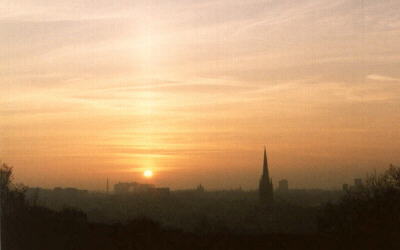
|
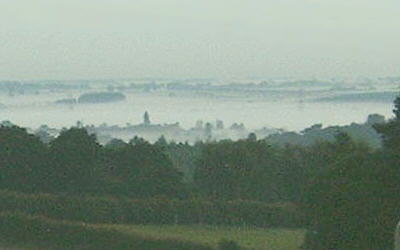
|
| "Sunset" over Norwich | Leicestershire in the "Early Morning Mist" |
|
In 1998 I moved away from Norfolk, my home for the past 42 years, and moved everything to Leicestershire. |
|
|
A fresh start, right in the center of Gt. Britain. |
|
|
My trustworthy Vauxhall "Carlton" estate being the only means of transportation for all of the equipment and clutter that I collected over the years ..... an excellent workhorse with just so much room. |
|
|
Alas, like dear old Norfolk, the Carlton is now (2008) also history. As with most motor vehicles, it finally started turning into "Metal Oxide". A material not even required as part of a recording media these days ! |
|
| - - - - - - - - - - - - - - - - - - - - | |
|
All change ..... Winding Down |
|
|
In 2001, I decided to take pen-to-paper. Writing articles on valve microphones and other equipment etc. Some articles appeared in the now much missed "Studio Sound", and excellent successor "Resolution". |
|
|
Of course, looking back to the 1990's, there was so much more happening in the world of professional recording, then there is today. Now, with the age of the "Home Studio", which is most probably based around a PC of some kind, there are less services asked of the pro-studios and hire companies. If you require a particular microphone or piece of outboard equipment, then you just use a suitable "Plug in" and away you go. Yes, this is an excellent way in achieving the sound you are striving for. However, at the end of the day, you cannot better the "Genuine" equipment for the job, and for many musicians/engineers, "Thank goodness", this is still the case. |
|
| - - - - - - - - - - - - - - - - - - - - | |
|
End of an era ..... Time to start the next chapter in my life |
|
|
Since 2000, there has been far less work coming in, and with major changes in personal circumstances (2014), then the path I take has to change also. So, after many hundreds of repairs etc, I now need to take on a new and quite different role in life. Hence the end of an era. Throughout the years I have worked on much equipment . Every now and then a really "Difficult to diagnose" fault would come along. On some such occasions, the faulty item might be put to one side for a while and come back to at a later date, enabling me to take a fresh look at the problem. I appreciated that this extra elapsed time was much to the annoyance of some of my clients. I say "Thank you", to those clients with the patience that was required on such occasions. |
|
|
|
|
|
Certain things carry on ..... |
|
|
I trust that my vast stock of the RV-14m (replacement valve for the VF14) will still be available for many decades to come. The U47 and U48 are great microphones, like many other classic models, and should be kept working for as long as is practically possible. |
|
|
Other products, such as the Missing Link PSU's and the PCL3 - "Phantom Conversion Lead" for the Calrec 600 series microphones, will be available until stocks are depleted. Most other products were hand built to special order. Thus now un-available. |
|
|
The "Take Two" sales list will continue for as long as is required. Much of my own personal recording equipment, from my private collection, being placed on the list in due cause. Such as valves, valve microphones and vintage hi-fi equipment etc. |
|
|
Other aspects of the website will be up-dated as required. |
|
|
So, Between the "Tasks" in my new lifestyle, it's time for another cup of coffee and transfer more of my old recordings to CD. Re-mixing/Re-mastering as and when needed. With the intension to release some of the more interesting recordings at a future date. |
|
|
Thank goodness I kept the majority of tape recorders that I used over the years (Many formats on Cassette/Reel to Reel//Digital etc). Just a shame about the aging process of the recording media e.g. Sticky Oxide on certain makes of recording tape, not forgetting the physical space required to store the recording media. |
|
|
|
|
|
Back to dear old Norfolk to retire ! |
|
|
After spending 21 years in Leicestershire, it was in August 2019 that I (together with Ann) moved back to the county of my birth, dear old Norfolk, now living in a chalet bungalow just half a mile from where I had lived for the first 42 years of my life. All belongings being transported either in the old Passat Estate, with longer items such as the M&GN "North Walsham" Town railway station sign, carried on the roof rack. All other items were transported in my Mercedes Citan van. Many journeys were needed, around 40, each being 250 mile round trips. On some days, two return trips were made. Still, all done and dusted as they say, with all my original recordings (many different formats including Betamax PCM etc) kept together with the original tape machines used at that time. That is a heck of a lot of equipment and tape to keep, and to find storage for ! |
|
| - - - - - - - - - - - - - - - - - - - - | |
|
Maybe, when I have the time to do it and now having very little of my original equipment left, I'll return to the world of recording. Ideally, to my first love in music ..... smooth, cool and laidback jazz. Alas however, time ticks by ever faster ..... "Time is now, but alas it was, for now time is present, and not what it was" A. C. Styles |
|
| - - - - - - - - - - - - - - - - - - - - | |
